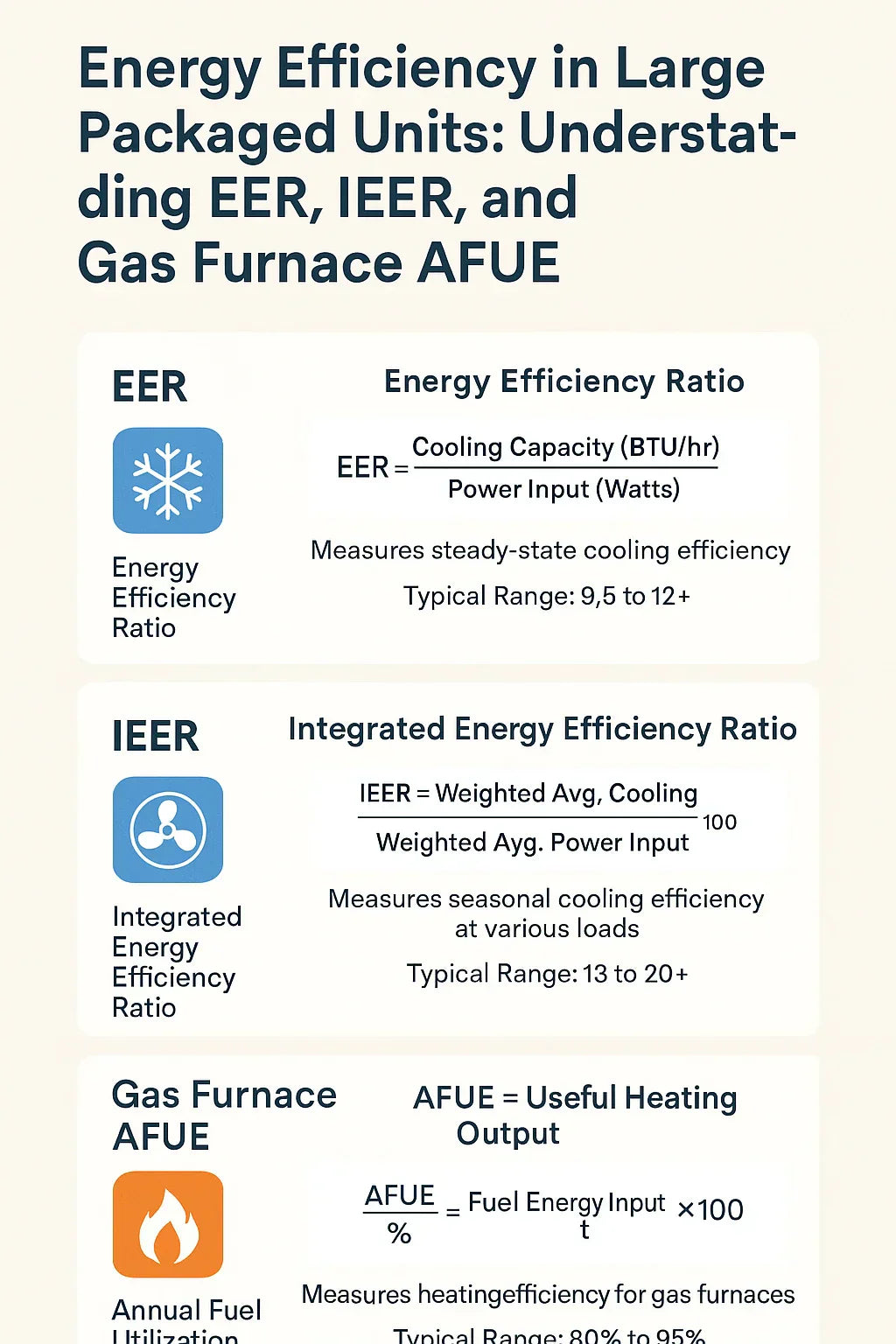📦 1. Introduction – Why Efficiency Ratings Matter in Large Packaged Units
In 2025, commercial HVAC efficiency isn’t just a nice-to-have—it’s a budget necessity. With energy rates still on the rise in most U.S. regions and stricter environmental standards kicking in, large packaged AC & gas furnace units need to be chosen with operational cost and performance in mind.
Best 6-10 Ton Commercial Packaged Air Conditioner and Gas Furnace Units
I’ve seen two identical buildings run the same tonnage HVAC, yet one pays 25–30% more per year in energy bills—simply because the unit’s efficiency ratings weren’t considered at purchase.
When you’re looking at 6–10 ton packaged units, three numbers will guide your decision:
-
EER (Energy Efficiency Ratio) – steady-state cooling efficiency.
-
IEER (Integrated Energy Efficiency Ratio) – seasonal cooling efficiency at variable loads.
-
AFUE (Annual Fuel Utilization Efficiency) – heating efficiency for gas furnaces.
Understand these three, and you can:
-
Accurately compare different models.
-
Predict operating costs.
-
Spot when “premium efficiency” is worth the price tag.
📏 2. Understanding EER (Energy Efficiency Ratio)
What EER Measures:
EER is a snapshot of cooling efficiency—how much cooling output (BTUs) your unit delivers per watt of electricity consumed, under specific conditions:
-
Outdoor temp: 95°F
-
Indoor temp: 80°F dry bulb / 67°F wet bulb
-
Full cooling load (100% capacity)
Formula:
Example:
A 10-ton unit = 120,000 BTU/hr cooling capacity. If it draws 12,000 watts at those conditions:
Typical EER Ranges in 2025:
-
Standard commercial packaged unit: 9.5–10.5
-
High-efficiency models: 11–12+
Pros of EER:
-
Easy to calculate.
-
Good for sizing electrical service and peak load planning.
Limitations of EER:
-
Only measures at one temperature/load point.
-
Doesn’t reflect part-load efficiency—important for most businesses that don’t run 100% cooling all the time.
🔄 3. Understanding IEER (Integrated Energy Efficiency Ratio)
Why IEER Matters:
Most commercial systems operate at partial load for much of the year—spring mornings, fall afternoons, or shaded parts of the building. IEER measures how efficiently the unit runs across a range of conditions.
How It Works:
IEER combines four test points:
-
100% load at 95°F outdoor temp
-
75% load at 81.5°F
-
50% load at 68°F
-
25% load at 65°F
Each point is weighted to reflect real-world usage patterns.
Typical IEER Ranges in 2025:
-
Standard efficiency: 13–15
-
High efficiency: 16–20+
Why IEER is Often More Useful Than EER:
-
Better reflection of annual energy use.
-
Highlights units with advanced features like variable-speed compressors and fans.
🔥 4. Understanding AFUE (Annual Fuel Utilization Efficiency)
AFUE applies to gas furnace heating sections of packaged units. It’s a percentage showing how much of the fuel’s energy actually turns into usable heat.
Formula:
Example:
A furnace with 90% AFUE turns 90% of the gas energy into heat, losing 10% through exhaust or other inefficiencies.
Typical AFUE Ratings in 2025:
-
Standard commercial gas furnace: ~80% AFUE
-
High-efficiency commercial gas furnace: 90–95% AFUE (condensing type)
AFUE and Cost Impact:
In cold climates, moving from 80% to 90% AFUE can save 10–15% annually on heating bills, depending on gas prices.
📊 5. Comparing the Three Ratings Side-by-Side
| Rating | Applies To | Units | What It Measures | Typical Range (2025) | Best Use |
|---|---|---|---|---|---|
| EER | Cooling | BTU/Watt | Peak-load cooling efficiency | 9.5–12+ | Comparing full-load performance |
| IEER | Cooling | BTU/Watt | Seasonal cooling efficiency at multiple loads | 13–20+ | Predicting real-world cooling cost |
| AFUE | Heating (Gas) | % | Annual fuel-to-heat conversion efficiency | 80–95% | Predicting seasonal heating cost |
💵 6. The Cost vs. Efficiency Trade-Off
Upfront Costs:
-
Higher EER/IEER or AFUE ratings = higher purchase price (5–20% more).
-
High-efficiency packaged units often feature premium components (variable-speed compressors, ECM fans).
ROI Timelines:
-
Hot climates: IEER upgrades can pay back in 3–5 years.
-
Cold climates: AFUE upgrades can pay back in 2–4 years.
-
Mixed climates: Balance both—ROI may extend to 5–7 years but still saves over the unit’s lifespan.
Example ROI:
-
Upgrade from 80% to 90% AFUE: $3,000 premium cost, $600/year heating savings → payback in 5 years, $3,000+ lifetime savings.
🌎 7. Climate & Application Considerations
-
Hot/Dry (Phoenix, Las Vegas): Prioritize IEER for long cooling seasons.
-
Cold (Minneapolis, Boston): Prioritize AFUE to control winter heating costs.
-
Mixed (Dallas, Atlanta): Look for balanced ratings—high IEER and AFUE in one package.
🛠 8. Jake’s Tips for Evaluating Efficiency Before Buying
-
Always request both EER & IEER—don’t settle for just one rating.
-
Cross-check ratings in the AHRI directory (ahridirectory.org) to ensure they’re certified.
-
Ask vendors for annual energy cost projections based on local utility rates.
-
Check for rebates—many utilities pay incentives for IEER ≥ 16 or AFUE ≥ 90%.
-
Consider lifecycle cost, not just first cost.
✅ 9. Summary & Action Plan
Before you buy a large packaged unit in 2025:
-
Identify your climate’s dominant load (cooling vs. heating).
-
Compare EER for peak load efficiency.
-
Compare IEER for seasonal cost impact.
-
Compare AFUE if using gas heat.
-
Factor in rebates and utility incentives.
-
Calculate total cost of ownership, not just upfront price.
In the next topic we will know more about: Rooftop Installation Guide for 6–10 Ton Commercial Packaged Units







